What to Keep in Mind When Marketing During Election Season

With election season comes amplified media consumption and, thus, a slew of opportunities and challenges for marketers. Some brands jump at the chance to put a stake in the ground by engaging in politically charged conversations, and others opt to remain bipartisan and operate business as usual.
Whichever approach your brand takes this election season, Backbone’s earned and paid teams compiled some helpful tidbits to keep in mind to make it through unscathed.
Adjust your KPIs as needed.
Election-related earned media coverage and paid advertisements will dominate national and state headlines until results are finalized in November (and beyond), and there will be implications to keep in mind across channels when developing relevant KPIs.
It’s important to keep in mind that just because the election will dominate the news cycle doesn’t mean there isn’t a chance for a brand story to be heard or a brand to stand out, but it does mean that the opportunities could be fewer and a little more challenging to land. In addition, based off insights from Amazon Reps, shopping decreases during the week of the election and is slow to ramp up for a few days post-election, so, to prepare for the anticipated reduction in consumerism, consider adjusting revenue forecasts for the days leading up to the election.
Expect a rise in ad costs and adjust your media mix accordingly.
While every platform will be impacted differently, political ad spending and therefore CPM costs are projected to increase most significantly in September and October leading up to election day in November. This will likely be a larger increase in costs than seen in previous years, as all political advertising is expected to be up 30% since 2020, and digital media investment up 156% since 2020 (Reuters, 2024). In addition to impacts in “battleground” states, media types and platforms are likely to have the most pronounced increases in costs.
- Linear TV: as with previous years, the bulk of political ad investment will go towards traditional TV buys at 71.9% of total spend (Statista, 2024), (TTD 2024 US Election Impact on Non Political Advertisers, June 2024).
- CTV + YouTube: though a smaller share of investment than broadcast/cable TV, campaigns are increasingly investing in alternative digital video formats. CTV in particular is expected to experience a 506% increase in political spending from 2020 (Insider Intelligence/ eMarketer, 2024). However, many vendors say increased CTV inventory will mitigate the expected rise in political advertising investment, limiting increases in CPMs. YouTube (where some CTV inventory is bought) maintains that 52% of consumers plan to spend more time of YouTube this fall to escape from traditional news video content (Google Elections Survey, 2024).
- Meta + Google: each platform is expected to make up approximately 4.5% of all political ad spending, a while it’s a much smaller share than video as a whole, it is a jump from previous years of political investment. Google will see political ad revenue up 215% from 2020, and Meta political ad revenue up by 86% from 2020 (Insider Intelligence/ eMarketer, 2024).
Be strategic and thoughtful with storytelling during the election season.
It’s no secret politics are polarizing, and connecting brands to these hyper-charged conversations can be both effective and detrimental to building a brand. It is up to the individual brand to determine if, and to what extent, it wants to be affiliated with specific issues and value-related topics.
With a hybrid/remote workforce, be mindful when engaging with media and audiences in areas with extreme local political happenings (“battleground” or “swing” states). Do a quick Google search before pitching regional stories and be ready to pause media as needed pending consumer sentiment in specific geographical areas. On social media, consider quieting feeds the Monday-Wednesday of election week to avoid any potential misfires.
If, considering the above, you have an angle that tightly relates to election themes, pitch it and be extra clear why it’s relevant. If you are steering clear of engaging with politics, keep in mind national news will be more difficult to land, and consider targeting select lifestyle and trade publications.
Prepare for the unpreparable.
Be ready for any crisis comms before you go out with a campaign. Think through possible scenarios and have a game plan for how to do damage control on social and across other channels. In planning, be sure to answer the following:
- How will we respond to backlash?
- Will we have a proactive statement if things go wrong?
- To whom will the statement be attributed?
- Do we engage with consumers on social media? If so, how?
Update your exclusions and take advantage of platform brand safety tools.
Each brand will have a different level of comfort with various political terms, however utilizing exclusion lists to confirm what kind of content any brand is appearing next to is essential for ensuring brand safety.
Many platforms (e.g., Google, The Trade Desk Programmatic buys, etc.) can implement exclusion keyword lists, which allow brands to remove themselves from appearing alongside content that is not aligned with its messaging or values. While many brands have “always-on” exclusion terms (e.g., war terms, violence terms, hate terms, etc.), brands may elect to add political terms during this upcoming election as political coverage heats up.
Additionally, many platforms have other brand safety tools to ensure ads are aligned with content that is deemed acceptable—see examples from Meta and Reddit.
Note: there is notable consumer testing that suggests that running ads next to news content does not negatively impact consumers' brand perceptions.
Consider shifting spend to platforms where users can escape the political noise.
According to the Google Elections Survey, consumers plan to spend more time on platforms where they can escape the noise this election season, with 81% of consumers planning to opt for media types beyond TV. This opens the door for platforms that encourage lighthearted content and have committed to no political advertising:
- Pinterest: since 2018, the platform has not accepted political campaign ads. Additionally, the platform does not monetize any organic content around the election, so brands can be assured Pinterest ads will not surround any vote, campaign names, or political content (Pinterest, 2022; Pinterest Advertising Guidelines)
- TikTok: the platform does not allow ads featuring political content across any monetization features, including paid ads, creators paid to make branded political content, and other promotional tools on the platform (TikTok Advertising Policies)
- LinkedIn: all political and politically adjacent ads are prohibited (LinkedIn Ads Policy).
Mark your calendars.
If you are planning campaign launches, media events, or product drops, be aware of major election dates to avoid coming off as tone-deaf.
Important 2024 Election Dates:
- September 10, 2024: Presidential Debate
- November 5, 2024: Presidential Election
- December 17, 2024: Electors Cast Their Votes
Battleground states:
- Nevada
- Arizona
- Wisconsin
- Michigan
- Pennsylvania
- North Carolina
- Georgia
If you have questions or need support for your brand this election season, reach out to us at info@backbone.media.


